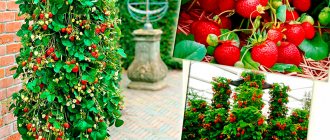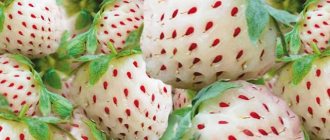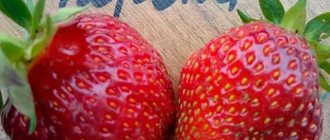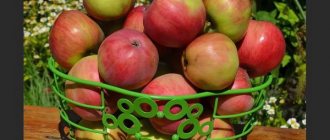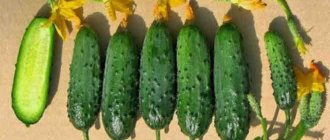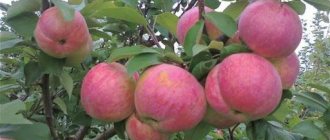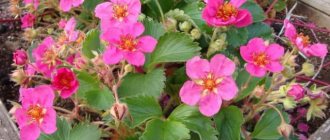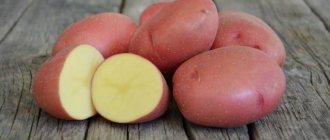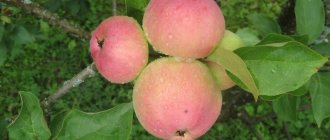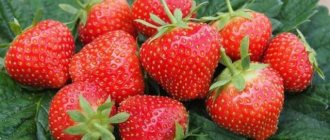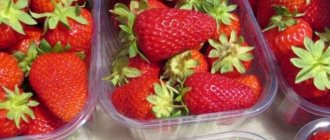The number of strawberry varieties offered by Russian nurseries has long exceeded several hundred. However, not all varieties of the crop combine excellent taste with keeping quality and transportability, which are necessary for cultivating strawberries for sale. Farmers and gardeners will like the Alba variety, suitable for both personal consumption and market sales.
Description of the variety
Alba strawberries are productive, disease-resistant, with good taste and the ability to maintain an attractive appearance for a long time. The variety was bred by Italian breeders for cultivation in continental climates; it is cultivated both in open ground and under cover. Without shelter, the variety begins to ripen in early June. When grown in greenhouses, the harvest can be harvested two weeks earlier, the berries will be tastier, and the yield will be higher.
Alba bushes are large, strong, beautiful. The height of the plant is about 35 cm. The foliage is large, the flower stalks are powerful, but they lie down under the weight of the fruit, so it is advisable to mulch the ground.
The berries are large, even in shape, have a beautiful red color and a shiny tint. The berries are identical in shape and size (about 30 g), the first ones are up to 50-60 g. The pulp is juicy, the taste is sweet and sour. Fruiting is extended, the size of the berries does not suffer. The yield from one bush is about 500-700 g.
Alba is one of the sweetest varieties of garden strawberries among the early ones. It is inferior in taste, if only to Clery.
Description of strawberries
Brief botanical description of the plant:
- Bush. Powerful, medium foliage. Height – 30-35 cm.
- Leaves. Large, bright green.
- Peduncles. Powerful, elongated, lay down when the fruits ripen.
- Fruit. Large, elongated conical shape. Average weight – 25-30 g. Berries of the same size. Color – red, surface – smooth, shiny.
Gardeners often confuse strawberries and garden strawberries. Let us note right away that Alba is a variety of garden strawberry, but people usually call it strawberry - it’s more familiar. We will also sometimes use a shorter, more common name.
Biological characteristics of the variety
This is a strong and beautiful plant. Powerful bushes have a height of about 30 cm. The leaves and peduncles are large. Under the weight of the berries, the flower stalks may fall to the ground.
Advice! To prevent the berries from getting sick and spoiling from contact with the soil, it is better to mulch the beds or use special stands for the berries.
A description of the Alba strawberry variety - in the photo above - would be incomplete without talking about the berries: reviews from summer residents say that they are special - they have a slightly spindle-shaped shape, beautiful color and shine. Absolutely identical and aligned berries attract the eye. The taste of the berries is controversial. Some people think it's sour. But the taste of strawberries of any variety is variable; it greatly depends on growing conditions, the number of sunny days and soil fertility. Given all the necessary conditions, Alba strawberries have quite a decent taste.
Advice! To improve the taste of the berries, feed strawberries not only with macro, but also with microfertilizers.
Characteristics of the variety
To evaluate the benefits of growing Alba and understand whether this variety is suitable for a particular region, pay attention to the agrotechnical characteristics of the variety.
Characteristics of the Alba variety:
| Parameter | Description |
| Productivity | Stated - up to 1.2 kg of berries per plant, real - 0.3-0.7 kg. On an industrial scale - 200-250 c/ha. |
| Resistance to diseases and pests | Practically does not suffer from powdery mildew. Average resistance to verticellosis and fusarium wilt. May be affected by brown and white spotting. |
| Drought resistance | Resistance to summer droughts. |
| Frost resistance | Resistance to spring return frosts. |
| Ripening time | Early ripening variety. The first berries ripen at the end of May, in the south even earlier. |
| Flowering time | In the south – mid-April, in the middle zone – in May. Flowering lasts 2 weeks. |
| Taste characteristics | The taste is good - sweet, with sourness. At the stage of technical ripeness – sour. |
| Aroma | Strawberry |
| Transportability | Excellent |
| Fruiting period | Long-term |
| Purpose | Universal |
a brief description of
Alba strawberries are better known among gardeners as an industrial crop that can be harvested from plantations using a mechanized method.
Advantages of the variety
- early ripening;
- gives a good harvest already in the first year of planting;
- berries are large throughout the harvest season;
- dessert taste;
- attractive appearance, non-marketable berries less than 10%;
- easy to transport, excellent keeping quality;
- If agricultural practices are followed, the yield can reach 1.0 kg. from a bush;
- frost resistance;
- drought resistance;
- high resistance to most diseases, especially powdery mildew and spotting.
Disadvantages of the variety
- in rainy, cold weather the berry becomes sour and becomes smaller;
- enhanced bevel formation;
- low resistance to verticillium.
Alba strawberries are demanding in terms of soil nutrition, therefore, in addition to standard fertilizing, it would not be amiss to fertilize the leaves with Plantafol, Reacom and Master; among folk remedies, a decoction of onion peels gives good results. Another feeding option: the drug Kristalon in combination with potassium humate.
Advantages and disadvantages
Alba's advantages:
- Ultra early ripening. Early ripening strawberries can be sold profitably.
- The timing of flowering allows you to avoid spring frosts.
- High productivity. In Russian conditions, the Italian yield of 1.2 kg is not possible, but 0.8 kg is a very decent result.
- High quality berries. Ideal for sale - the berries are large, have dense pulp, tolerate transportation well, do not leak, and have an excellent appearance.
- Good dessert taste. It can be better, but for such transportability and keeping quality as Alba has, the taste is simply excellent.
- After harvesting, the fruits are stored without losing their taste parameters.
- The variety is unpretentious and adapts well to different climates.
- It has good immunity and is resistant to various pathologies.
- Tolerates the winter well and does not require insulation.
Disadvantages of the Alba variety:
- In extreme heat, the surface of the berries becomes slightly baked.
- When compared with dessert varieties, it is significantly inferior in taste.
- Affected by some types of spotting and other diseases.
An overview of the Alba variety is provided in the video below:
History of the development of the strawberry variety
A little over two decades ago, a breeding plant was created in Italy, whose specialists have been developing new varieties of strawberries all this time.
These berry crops had to have:
- good yield;
- high resistance to major diseases;
- ripe fruits could be stored for quite a long time after picking;
- the harvested crop would withstand transportation well at any distance;
- the berries would have a wonderful appearance and a wonderful taste.
Photo of Alba strawberry
Strawberry varieties that are grown on an industrial scale must have all these qualities for further sale in large volumes. But even in small private farmsteads, gardeners are happy to plant strawberries on the beds, which are distinguished by the same high characteristics.
Work on breeding the Alba variety was carried out at the end of the last century. To obtain new strawberries, the parent forms Cal.07.86-6 and Albion were crossed. Breeders worked on breeding Alba for several years, then the strawberries were tested and only in 2003 were they patented in Italy.
ALBA - one of the earliest strawberry varieties - video
On a note!
The Alba strawberry variety is recommended for cultivation in regions with a continental climate.
Seedlings of this variety came to Russia a couple of years after the Alba strawberry was patented. And currently it is successfully grown in many Russian regions.
Choosing a site for planting Alba strawberries
To get the promised harvests from Alba, you need to create optimal growing conditions for it. To do this, select a suitable site, plant the plants, provide them with care - watering, fertilizing and other agrotechnical measures.
The place for the beds is selected according to the following criteria:
- Illumination. The area should be well lit. Shaded areas, such as near tall trees, are not suitable.
- Wind protection. To prevent the bushes from being damaged by gusts of wind, you can plant currant or gooseberry bushes between the beds.
- The soil. Sandy and sandy-loamy soils with a humus content of at least 3% are more suitable than other soils. Saline and calcareous areas are not suitable.
- Humidity. Areas with low humidity levels are suitable - at higher elevations, and with low groundwater levels.
- Predecessors. It is recommended to plant after radishes, beans, garlic, peas, and mustard. Not recommended - after raspberries. Precursors related to nightshades (tomatoes, eggplants, peppers, potatoes) are contraindicated for strawberries, since they suffer from the same dangerous disease - late blight. It is also not recommended to plant strawberries after sunflowers and corn - these powerful plants greatly impoverish the soil. Legumes are dangerous from nematodes - they themselves, without being sick with the strawberry nematode, are its carriers. Cabbage and cucumbers are also not suitable; they suffer from a common disease with strawberries - stem nematode and verticillium wilt.
Strawberries should not grow in one place for more than 3-4 years - the location of the beds must be changed regularly.
Preparing beds and planting planting material
To provide strawberries with the most favorable development conditions, it is necessary to choose the right location for the bed and carefully prepare it.
Preparing the bed
Remember that you need to change where you plant your strawberries every 3-4 years.
Try not to plant strawberries in areas that were previously occupied by tomatoes, potatoes, cabbage, peppers, eggplants, zucchini, and raspberries. The best predecessors are radishes, beans, garlic, peas, mustard.
The location for strawberry beds must meet the following criteria:
Recent Entries
5 working ways to use tar in the garden 7 indoor plants that help you get married even in adulthood Indoor plants that can bloom in trouble
- illumination. Strawberries need sunlight for normal growth and development, so do not place the beds in shaded areas (for example, next to tall garden trees);
- wind protection. To protect the bushes from damage that can be caused by gusts of wind, and at the same time not to shade them, some gardeners try to place beds between gooseberry or currant bushes;
- suitable soil. Strawberries grow best on sandy or sandy-loamy soil with the addition of humus (there should be 3% of it in the soil). Avoid chalky or saline areas;
- low humidity level. For planting, it is advisable to choose an area located on a hill or a flat surface with deep (at least 1.5 m) groundwater.
An open horizontal bed is the most common and easiest to make. This is done as follows:
- To begin, choose a location for the garden bed and determine its size. If you plant strawberries in one or two rows, then the width should not exceed 40 cm in the first case and 80 cm in the second. The distance between rows should be 30–40 cm.
- Dig up the area.
- Add any nutrient mixture to the soil: a bucket of soil + a bucket of compost + a bucket of manure + 1 liter of ash solution; a bucket of humus + 20 g of potassium salt + 40 g of superphosphate; bucket of compost + 40 g of superphosphate + 0.5 l of ash solution. For 10 m2 take 2 buckets of fertilizer. If you are making a bed in the spring, then add urea (1 tbsp per 10 l).
- Make rows.
- If desired, reinforce the sides of the bed with boards or pieces of slate.
The efficiency of such a bed can be increased by using agrofibre.
- Prepare the bed by removing all weeds and fertilizing it.
- Cover the area with overlapping covering (the pieces should cover each other by 20 cm).
- Strengthen the cover with staples (you can use bent pieces of wire) or dig a trench along the edges of the bed, place the ends of the cover there and bury it.
- In the places where you want to plant strawberries, make small cross-shaped or round cuts into which the seedlings are planted.
Video: planting strawberries on agrofibre
You can also make a warm raised bed for strawberries.
- In the place where you plan to plant the strawberry row, dig a trench approximately 40 cm deep.
- Fill it with the following layers: the bottom one - large chopped branches; 2nd - vegetable “garbage”: dry mown grass, dry leaves, compost, sawdust. Compact this layer and pour warm water. 3rd - fertile land. This layer will rise 25–30 cm above the surface, but you can level it.
- Add fertilizer to the soil (the same as for an open bed).
The bulk bed turns out to be quite high
Planting strawberries
Strawberries are planted in open ground in spring (most preferably), summer and autumn. Spring planting dates may vary depending on the region:
- south - first 2 weeks of March;
- middle zone - last 3 weeks of April;
- north - first 2 weeks of May.
Disembarkation process:
- In the prepared bed, make holes 7 cm deep. They should be located at a distance of 20 cm from each other.
- Fill the holes with humus and add warm water with the addition of potassium permanganate to disinfect the soil.
- Remove the seedlings from the containers. An hour before planting, it must be watered well. If the bushes have developed long roots, cut them back to 7–10 cm.
- Carefully plant the sprout in the hole, making sure that the apical bud is on the surface.
- At first, shade the sprouts from direct rays.
When planting strawberries, you must ensure that the apical bud remains above the ground
Summer planting of strawberries takes place from mid-July to mid-August. Since the temperature in summer is higher than in spring, choose cloudy, cool days for planting (evening is also suitable).
The best time for autumn planting is from the end of August to the second week of September. Planting rules are the same, but avoid adding nitrogen fertilizers to the soil to prevent leaf growth.
It is better to cut off the flowers of all sprouts in the first year of life - this will help the young plant grow stronger and form a strong root system.
Video: planting strawberry seedlings in open ground
Soil preparation
Open horizontal beds are most suitable for growing strawberries. They are very easy to make:
- Having chosen a place for the beds, decide on its size. If there are 1-2 rows, then the width of the bed will be 40 and 80 cm, respectively. Leave 30-40 cm between rows.
- Dig up the ground. Select weed roots carefully. Prepare the soil in advance, at least 2 weeks before planting the seedlings.
- During digging, add 1 sq. m area of fertilizer in the form of a mixture:
- humus - 1 bucket;
- complex fertilizer - 50 g (or 30 g of superphosphate with 1/2 cup of ash).
- Dig rows for planting. The sides of the bed can be strengthened - for example, with boards or pieces of slate.
It is better to prepare the soil for spring planting of strawberries in the fall, and for autumn planting in the spring.
Helpful tips for soil preparation:
- To prevent weeds from growing on the land where you are planting strawberries in the summer, sow it with green manure.
- Do not apply fresh manure to the strawberries - it contains a lot of pathogenic bacteria and weed seeds.
- If the beds for strawberries are prepared in advance, you can add half-rotted manure. But be sure to water the soil with “Baikal” or “Shine” - they contain microorganisms that will process organic matter into compounds accessible to strawberries.
Strawberry propagation methods
The choice of Alba's antennae was discussed above. The plant is propagated by dividing the bush. It is dug up and cut into several pieces with a sharp knife. It is important that each has a developed root system and part of the heart. Wounds from the tool are sprinkled with ash or chalk.
Seedlings are grown from seeds. They are dried and soaked in water. Keep it for 5 days, changing the water 2 times a day. Pour onto a baking sheet and heat for 7 hours in the oven at 35°. Rotted manure is mixed with low-lying peat and sand in equal parts and poured into containers. Planting material is embedded into the soil to a depth of 5 mm, watered and covered with cling film. The soil is moistened as it dries.
Landing
Strawberries are planted at any time except winter. Gardeners prefer spring planting.
Its timing depends on the region:
- in the south - in the first half of March;
- in the middle zone - in the last three weeks of April;
- in the north - in the first half of May.
Strawberry planting process:
- In the bed prepared in advance, dig small depressions - 6-8 cm deep. The distance between neighboring bushes is 20-25 cm.
- Add humus to each hole, 1 tbsp. l. ash and a pinch of complex mineral fertilizer. Pour a warm solution of potassium permanganate (light pink) for disinfection. Watering rate is 0.5 liters per hole. The same amount of water is poured after planting the bush.
- Remove the seedlings from the containers - they are kept in the shade for about 6 hours. For planting, take plants that have grown from runners that are up to one year old. Water the seedlings one hour before planting.
- It is recommended to place the seedlings in a nutrient solution before planting. Dissolve humate (1/2 tsp), phytosporin or rootin (incomplete tbsp) in 2 liters of water.
- If the bushes have grown roots that are too long, use pruning shears to reduce them to 8-10 cm.
- Carefully place the bush in the hole. Pay attention to the apical bud - it should not be buried in the ground. The roots do not bend when planting - they should be positioned vertically.
- At first, protect the planting from direct sunlight.
Tips for planting strawberries:
- If you plant seedlings in the summer, choose cool, cloudy weather. The recommended planting period is mid-July to mid-August.
- When planting in autumn, do not apply nitrogen fertilizers - they promote leaf growth. The best time to grow seedlings is the end of August - the second week of September.
- In the first year after planting, pick off the flowers - let the plant first get stronger and form powerful roots.
Planting and care
The largest strawberry that we managed to grow weighed more than 230 g. However, the taste left much to be desired. The achievement was recorded in 1983 in the USA (city of Rolkston).
In addition to the general recommendations that need to be followed in order to consistently obtain a harvest of garden strawberries, Alba has specific cultivation features. It is very demanding when it comes to watering during the berry ripening period. But here it is important not to overdo it. In the near future, a garden bed turned into a swamp means rotted plant roots and berries, which often fall to the ground under their own weight.
Choose a place for Alba that is well lit and warmed by the sun, without drafts. If you plant it in the shade, the berries will turn out unsweetened, almost tasteless and watery. Remove garden strawberry plantings as far as possible from fruit trees, shrubs and any nightshade plants (tomatoes, potatoes, eggplants, tobacco, bell peppers). Otherwise, infection with verticillium is more than likely. Nightshades themselves do not suffer from it, but they are carriers of the disease.
The culture is unpretentious in terms of soil. But you will get the maximum yield by planting strawberries on light sandy or sandy loam soils with normal or slightly acidic acidity.
Table: growing garden strawberries of the Alba variety
| Term | Recommended Procedure |
| In the fall before planting | Adding 5–7 kg of cow manure, humus or compost and 50 g of complex fertilizers containing nitrogen, phosphorus and potassium per 1 linear meter of bed into the soil. Then the planting area is dug up to a depth of at least one spade bayonet. Seedlings or mustaches are planted only when the bed has settled (not earlier than after 2-3 days). |
| When planting in the ground (September) | Plant each bush so that the rosette from which the leaves grow is flush with the top edge of the hole. Do not crush the roots under any circumstances. Dig a hole at least 20 cm deep. Alba bushes are quite compact, so maintain a distance between them of about 30–40 cm. It is advisable to plant strawberries in a checkerboard pattern, since one bush “pulls” nutrients from an area of 0.1 m² for normal development. There is no need to make more than three rows. Then it will be very inconvenient to pick berries. When planting, pour 0.5 liters of water into the bottom of each hole and add a handful of wood ash and dolomite flour mixed in equal proportions. The latter can be replaced with ground eggshells. Or mix the soil removed from the hole with the same amount of peat and special soil for strawberries and fill the holes with this substrate. |
| November | Before the first frost, strawberries need to be protected from the cold. Of course, Alba is positioned by the creators as frost-resistant, but this definitely won’t do any harm. Use special covering material or ordinary coniferous tree branches. |
| Early April | As soon as the sun begins to warm up, remove what you covered the strawberries with. Otherwise, the plants may well rot and rot will develop. |
| Spring (when the soil has completely thawed) | Starting from the moment when the temperature reaches about 10ºC at night until the berries set, once every 10 days, at your choice, carry out one of the following feedings:
Starting from mid-April, watering is required, in small portions (0.3–0.5 liters per plant, depending on the age of the bush), but at least twice a day - in the morning and in the evening. In the southern regions you can water three times. |
| Before flowering | Mulch the soil. It’s not for nothing that the British call strawberries strawberry, that is, “straw berry.” Any mulch (straw, rotted sawdust, sunflower seed husks) is an effective means to prevent the garden bed from becoming overgrown with weeds, to loosen the soil and prevent contamination and rotting of the future crop. Then it is useful to pour the strawberries with a solution of Azofoska or urea (30 g per 10 liters of water), or an infusion of wood ash. One bush takes 0.5–1 liter. Starting from this time, at intervals of 3-4 weeks, while the leaves remain green, spray with Sudarushka, Ryazanochka, Nutrivant-Plus, Gera, Zdraven, Rubin, Agros. Pay special attention to the inside of the sheet. It is she who is “responsible” for the absorption of nutrients. Prepare the solution strictly following the manufacturer's instructions. |
| During flowering | Spray the leaves with the following solutions:
Yeast is the most preferred folk remedy. Alba benefits from watering with an infusion of fresh or powdered yeast. In the first case, 1 kg of yeast is cut into small pieces, poured into 5 liters of warm water, left for 4–5 hours and filtered. In the second, 10 g of powder and 50 g of sugar are poured into a glass of hot water and stirred vigorously. When the sugar has completely dissolved, pour the contents of the glass into a bucket, add 10 liters of water and leave for 2-3 hours. |
| 3–4 weeks after the start of fruiting | Mustache trimming is required. This preventive measure will not only increase the yield, the size of the berries, and make it easier for you to pick them, but will also help the plant protect itself from diseases. |
| 3 years after planting in the ground | It is not recommended to grow strawberries in one place for longer than 3 years. After this period, new beds must be prepared in compliance with all recommendations. Alba can be planted in its original location no earlier than after 4 years. |
Yes, exactly an hour ago we tasted the first Alba berry from the spring planting. A slightly unripe berry was specially picked to check for lice... that is, for acidity. Quite pleasant taste, not sour. I really liked that the bushes, having barely taken root, immediately rushed into battle. Not all varieties of spring planting gave such a start.
Anyuta
https://forum.vinograd.info/archive/index.php?t-3195.html
Further care
After planting - in spring and summer, strawberries need regular care. During autumn planting, all activities are postponed until spring - except for insulation, if any.
Watering
Watering is carried out as needed. On average, strawberry beds are watered every 5-6 days. When watering, it is important to maintain a balance - Alba does not like dry soil, but excessive importance is contraindicated for her. Overmoistening leads to the development of fungal diseases.
Water the strawberries with warm water (about 20 °C). Watering rate – 10 liters per 1 sq. m. Water is poured at the root, so that splashes do not fall on the leaves, flowers and berries. It is better to water with a watering can or using drip irrigation; a hose is not recommended - a powerful stream can erode the soil and expose the roots. The best time for watering is evening.
Top dressing
Feeding order:
- Feeding begins with the onset of warm weather. The soil temperature should reach 8-10 degrees Celsius. We recommend that you additionally read our article on spring feeding of strawberries.
- After clearing the bed of weeds, water the bushes with iodine solution (7-10 drops per bucket of water). Water in the evening to prevent the leaves from burning. Treatment is carried out 2-3 times - before fruiting begins. Iodine “baths” will protect plants from gray rot.
- A week after treatment with iodine, add urea to the soil. Prepare a solution - add 1 tbsp to 10 liters. l. urea. Water the bushes with this solution - 0.5 liters per bush.
- During the flowering period, fertilizing with yeast is recommended. How to prepare the mixture:
- Take a 3 liter jar. Pour sugar (0.5 kg) and dry yeast (10 g) into it.
- Fill the ingredients with water - not reaching a few centimeters to the top.
- Place the mixture in a warm place for a couple of days to ferment.
- Dilute the mixture with water (10 liters - 1 tablespoon) and pour it over the bushes. For each bush - 0.5 liters of solution. Half a month after fertilizing with yeast, sprinkle the rows, or the soil near the bushes, with ash.
- During the fruiting period, it is also useful to add ash, dry or in the form of a solution. Dry ash is added at the rate of a handful of ash per bush. Solution – 0.5 l per bush. Prepare the solution as follows:
- Pour boiling water over 0.5 liters of ash and leave for 3 hours;
- dilute the mixture with 10 liters of water.
- It is also recommended to feed strawberry plantings with potassium monophosphate (per 10 liters - 1 tablespoon) and cow manure (dissolved in water 1:10) or chicken manure (1:12).
- In the fall, repeat fertilizing with ash or apply complex fertilizer.
Mulching
If agrofibre/film was not used during planting, the soil must be mulched later. Advantages of mulching:
- no need to weed the beds;
- the number of waterings is reduced;
- stable soil temperature is maintained;
- leaching of nutrients is prevented.
You can mulch the beds:
- compost;
- straw;
- sawdust;
- agrofibre.
The mulch is periodically updated. Gardeners who do not want to mulch their beds should regularly loosen the soil and pull out weeds. It is also advisable to periodically hill up the bushes - the roots may become exposed after watering.
Preparing for winter
Pre-winter preparation activities:
- Remove all dried leaves.
- Trim the mustache so that only the apical bud with green leaves remains.
- In regions with harsh winters, it is recommended to cover strawberry beds. For example, spruce branches.
Growing
According to breeders from New Fruits, Alba strawberries do not require special care when growing. Perhaps in the northern part of Italy it is not whimsical, but, unfortunately, it is very vulnerable to the “harsh” Russian climate. Russian gardeners will have to work hard to get a high-quality harvest.
Alba is demanding of sunlight, so when planting this crop it is necessary to choose a well-lit place, without shadows at certain intervals. If you plant the plant in the shade, then the berries will take a very long time to ripen and will be poorly saturated with sugar.
This crop is planted according to the standard pattern of 40x60 cm. Also, denser plantings such as 25x35 cm are also suitable for it, but the first one is preferable. They reproduce by means of their mustaches. Young rosettes begin to bear fruit only with abundant watering and high air temperatures. Therefore, the best time for propagation of the bush with mustache is the end of July - beginning of August. If propagation is delayed, then the new flower stalks will not have time to fully take root, which will lead to their freezing in the winter.
Alba needs periodic feeding. It is also necessary to monitor the quality of the soil.
To increase productivity, feed the bush 4 times per season. The first time they do this is in the spring, during the thaw. Rotted manure is applied under the plant. It will allow the strawberries to wake up and quickly enter the phase of active development.
During the maximum load on the bush, and this is the period of flowering and ripening of berries, two additional feedings are applied. These include spraying the crop with an infusion of wood ash, or with special fertilizers that contain iron, phosphorus, and potassium.
After harvesting, fertilizers are applied again. It is important that they do not contain nitrogen, as it provokes increased growth of the crop. And in winter, you need to prepare the plant for hibernation, and not fruiting.
During the dry period, Alba is watered 2-3 times every 7 days. If you neglect watering, then the berries will be dry and will lose a lot in volume.
In winter they make a blanket for the strawberries. Sawdust, straw, etc. are perfect for it.
The variety is very vulnerable to anthracnose. At the first signs of the disease, the plant is treated with special preparations.
When and how to pick berries?
Early ripening Alba produces a harvest in May. The bushes bear fruit for a long time, so the berries are collected in several stages. The variety is good for fresh consumption, but it is usually used for preparations - making strawberry jam, jams, and preparing sweet desserts.
Picking the berries is not difficult - they are easily separated from the stalk. Experienced gardeners often cut berries with stalks - this is more painstaking work. The collection is carried out in the morning, when the dew has gone, or in the evening, when the sun ceases to be hot. The main condition is dry weather.
To keep berries longer, gardeners advise:
- pick berries 2 days before technical ripeness;
- Do not water the plantings abundantly, especially shortly before harvest.
During harvesting, the berries are immediately discarded:
- wrinkled;
- affected by mold;
- damaged.
If one bad berry gets into the box, then in one day all its contents can be spoiled.
Harvest and storage
Alba begins to bear fruit in May. In the southern regions, the fruiting period extends throughout the summer. A dense berry, collected from a bush along with the stalk, can remain fresh for 4 days at room temperature. In the refrigerator, the shelf life increases to a week, and if the berries are frozen, they can be stored for 8 months.
Be sure to store unwashed and dry berries, then they will last longer. If the fruit is wet, then it must be dried with paper towels. Only ripe, firm berries without defects are suitable for freezing.
Although gardeners regularly argue about the taste of Alba strawberries, thanks to its characteristics, the plant confidently continues to gain popularity among summer residents. A minimum of high-quality care is enough for him to get a magnificent harvest of fruits.
Diseases and pests
The Alba variety, being immune to a number of strawberry/garden strawberry diseases, is not immune from being affected by some diseases to which it is not so resistant.
The most common diseases of the Alba variety:
| Disease | Symptoms | How to fight? |
| Late blight | The leaves turn gray, become cup-shaped, wither and dry out. There are few or no fruits. If left untreated, bushes die within 2-3 years. | Maintain crop rotation. For prevention, treat the roots with solutions of Humat (15 g per 1 liter) or Agat 25K (7 g per 1 liter). |
| Brown and white spotting | Red-brown spots appear on the leaves. Later - round spots, gray or white in the center. Leaves wither and die. The stalks and petioles are also affected. | Spring treatment with 4% Bordeaux mixture. Treatment with a weak solution of potassium permanganate, Falcon, Metaxil or Ridomil. |
| Anthracnose | Dark spots appear on leaves, ovaries and fruits. Dead tissue breaks, the stem of the rosette inside turns brown. | For prevention, starting from the moment the leaves grow, the bushes are treated 2-3 times with Bordeaux mixture 2%. When the first symptoms of the disease appear, the bush is sprayed with Anthracol (per 10 l - 15 g), but no later than 7 days after the appearance of signs of the disease. |
The most common pests of the Alba variety:
| Pests | Damage caused | How to fight? |
| Aphid | Drinks juices from leaves and other parts of the plant. Leaves curl and die. The whole bush withers. | Spraying with a soap solution (60 g per 1 liter of water) or special insecticides. You can also spray the plantings with garlic solution (for 10 liters take a glass of garlic and onion juice, and 150 ml of dandelion juice). |
| Weevil | Beetle larvae eat flowers and ovaries. The buds dry out, the ovaries and fruits develop poorly. | It is prohibited to plant raspberries near garden strawberries. Remove diseased and old leaves in a timely manner and loosen the soil. Spray with a solution of potassium permanganate and treat with Inta-vir. |
| Strawberry mite | Damages leaves and fruits. Leaves curl, darken and die. If you do not provide help, the plant dies. | Treat with Karbofos or colloidal sulfur (per 10 l - 8 g). In advanced cases, the dose is increased to 15 g. |
How are garden strawberries different from strawberries?
Almost all gardeners are sincerely confident that they grow strawberries in their garden. But in 95% of cases this is completely wrong. The correct name for beautiful, fragrant and wonderfully tasty red berries is garden (or large-fruited) strawberries.
Strawberries are practically never found as a cultivated plant. Garden strawberries have many artificially bred hybrids, but in the wild they do not exist in principle.
In addition to the well-known red one, there are also white strawberries. It was bred back in the 18th century, but these varieties have not survived to this day. Modern breeders have brought it out again by crossing wild strawberries and pineapples.
Both plants belong to the same genus. But strawberries are musk or nutmeg strawberries (Fragaria moschata), and garden strawberries are known to botanists as pineapple strawberries (Fragaria ananassa).
If we talk about external differences, strawberries have rather small, reddish-purple berries with a strong, characteristic aroma. They are long and pointed in shape. Another characteristic feature is the presence of male and female plants. The former are needed only for pollination and do not bear fruit. Female flowers need pollination to produce berries. This is associated with low productivity.
Garden strawberries pollinate themselves. Its berries are much larger and sweeter, with a characteristic sourness. It has high productivity.
The strawberry bush is taller (about 25–35 cm), the leaves are larger, corrugated throughout the plate, light green in color. Her mustache is shorter than that of a strawberry; there are significantly fewer of them.
Unlike garden strawberries, which are quite drought-resistant, strawberries love shade and moisture; in the heat and without watering, this crop simply withers.
But for a gardener, these differences, in general, do not matter. The only thing that worries him is the yield and quality of the berries. Therefore, almost no one grows real strawberries on their plots.
Strawberries and wild strawberries are the only berries whose seeds are not hidden in the pulp. Botanists call these seeds nuts, and the berry itself is called a polynut.
How is the variety propagated?
Alba is propagated in different ways. Usually the method of rooting tendrils or dividing the bush is used. Gardeners rarely resort to propagation by seeds.
Methods of propagation of Alba garden strawberries:
- Dividing the bush. Procedure: in the spring, when the temperature is above zero, choose 2-3 year old bushes that consistently bear fruit;
- carefully remove the bushes from the soil, trying not to damage the roots;
- divide the roots into 2-3 parts using a sharp sterile instrument - each fragment must have a rosette with leaves;
- the cut site is treated with a solution of potassium permanganate;
- separated bushes are planted in prepared holes.
- Prepare the soil mixture - mix peat and soil 1:1. Humus is added.
- seeds are soaked for 2-3 days in a slightly pink solution of manganese or in a growth stimulator;
Reviews from netizens
We have been growing Alba for 2 years now. This year in our region it was a market favorite in terms of marketability and price. Compared to Clery, it surpasses it in yield. After the berry turns red, you need to keep it on the bushes for 2-3 days, then it will gain the appropriate taste. Of course, there is no such aroma as Rozana Kievskaya, but for a market berry we still have to look for something more worthy. Maybe someone knows something even more worthy? Share your experience
Alexander Krymsky
https://forum.vinograd.info/showpost.php?p=558477&postcount=30
Reviews
★★★★★
Anton E., Kursk region. The variety is productive, with very large berries.
Transports well - does not leak juice. Looks attractive, the berries are strong and shiny. The pulp is moderately dense, not hard. It begins to bear fruit early - it is possible to sell the berries at a good price. ★★★★★
Valentina R., Moscow region. If there is a year without frost, then Alba is the first to open the fruiting season - it is 5-7 days ahead of other early varieties.
The berries do not have a special aroma, and the berries look like they are made of plastic; the taste is average. Transportation and safety are excellent. Hide
Add your review
Garden strawberries "Alba" are more suitable for industrial cultivation. Thanks to its excellent transportability, shelf life and excellent presentation, it can be successfully sold on the markets. In terms of taste, this large-fruited variety will appeal to those who like a combination of sweetness with a slight sourness.
0
0
Copy link
Description of the variety
Alba strawberries owe their appearance to the breeders of the famous agricultural company New Fruits (Italy). The task was set to obtain an early productive variety that combines excellent taste characteristics, transportability, and presentation.
Alba fully meets these requirements, although judging by reviews and ratings, there is constant debate about the taste of the berries.
Among the parent forms is the well-known variety “Albion”, with large “crispy” berries. The year of breeding of the variety is 2003; in Russia, early large-fruited strawberries have become known since 2005. The registration number of the bred variety in the supervisory structure of Europe is No. 16744. Alba is not yet registered in the State Register of the Russian Federation.
It is grown on a large scale in Italy, the CIS countries, and Russia. Reviews are mostly positive, complaints are usually based on taste. But you shouldn’t expect strong sweetness from an early variety; after all, in spring and early summer there is not enough sun, and the berries do not have time to gain sugar content.
Suitable region and climate
Alba is widespread not only in Italy, but also in many other European countries. In Russia, it grows magnificently in the Crimea and Krasnodar Territory, in the Stavropol region, the Central Black Earth region and in the middle zone. It can also grow in more northern regions, provided that the berry plantations are covered for the winter. The variety is also popular in Ukraine and Belarus.
Having studied the reviews of gardeners, we can draw the following conclusions:
- The advantages of Alba include its high yield, early ripening, excellent commercial quality of fruits, transportability and shelf life, sufficient frost resistance of plants, high drought resistance, and resistance to a number of diseases.
- Disadvantages are taste qualities that not everyone likes, vulnerability to anthracnose and susceptibility to aphids, freezing of plants in climates with harsh winters.
Although there are those who are disappointed in the taste and aroma of Alba, this does not make it less popular, especially among small farms and larger enterprises. And gardeners are not averse to having this early variety in addition to other, later ones, in order to be able to enjoy fresh strawberries already in May, which have also never failed in preparations for the winter.
Of course, it’s not worth growing just this one variety on your plot. And as an addition to the strawberry variety, Alba will be simply irreplaceable.
Landing Features
Agronomists advise planting seedlings in August or July, but only after the summer heat has subsided. With a later planting date, productivity deteriorates. It is possible to plant plants in mid-spring, but fruiting will not occur until next year, although there are exceptions. The bushes take root well and grow quickly. Alba loves sparse planting, so using the two-line method, maintain a distance of 20 cm between plants and 40 cm between rows.
You need to choose a place for strawberries in a sunny area. The more nutritious the soil, the better the strawberries will bear fruit. It is advisable to lay out a strawberry bed using mineral and organic fertilizers a few weeks before planting. Immediately after planting, the soil is mulched with straw or grass clippings. Sawdust, agrofibre and compost are suitable as mulch.
Attention! Alba can be grown from seeds. In this case, their planting date should be no later than the beginning of March.
Reproduction
Alba strawberries are successfully propagated in several ways, and you can choose the option that is most convenient for you.
Propagation by seeds
Since the Alba strawberry is a hybrid plant, you won’t be able to grow a new bush from the removed seeds, and you will have to buy them again.
Germination and stratification of seeds
Usually, they begin to sow strawberries for seedlings in February or March, so that when they hatch, the sprouts can immediately receive a sufficient amount of light. Seeds of large-fruited crops, which include Alba, germinate slowly, so it is recommended to soak them before sowing. The technology is as follows:
- Take a piece of cotton cloth and moisten it well with soft (melt, rain, boiled, settled) water.
- Place the seeds on one half of the piece of cloth and cover them with the remaining half.
- Place the fabric in a plastic bag and place the workpiece in a warm place for 2 days. Make sure the fabric is constantly damp.
It is advisable to soak large-fruited strawberry seeds for better germination.
If you want to get early Alba seedlings, then it is advisable to stratify the seeds. To do this, place the bag with the cloth (the preparation is the same as for germination) in the refrigerator on the bottom shelf for 2 months (usually this is done in November). During this time, make sure that the fabric does not dry out, so use a spray bottle to moisten it as needed.
When stratifying seeds, you can use a plastic container instead of a bag.
Sowing seeds in the ground
After all the preparatory measures have been carried out, strawberry seeds can be sown for seedlings. But first prepare the containers and soil. It is advisable to sow the strawberries first in one common box 15 cm high, and then plant the sprouts in separate pots.
When sowing strawberry seeds, you need to remember that they do not need to be buried
Step by step process of planting seeds:
- Cover the bottom of the box with drainage material (expanded clay, fine gravel) to a depth of 2–3 cm.
- Pour soil over the drainage so that the box is half filled. Mixtures can be as follows: garden and forest soil with a small amount of sand (about 1/10 of the total amount of soil); turf, peat, humus and sawdust in equal parts.
- Lightly compact the substrate and moisten it with soft, warm water from a spray bottle.
- Place the seeds in the box using tweezers. There is no need to cover the seeds.
- Cover the box with transparent film, having previously made several holes in it, and put it in a warm, dark place, but not in direct sunlight.
- Make sure the soil does not dry out and water it as needed.
Shoots may appear in 3 weeks (if you stratified the seeds, then in a few days). Try to ventilate and harden the seedlings daily, leaving them in the open air for 2–3 hours at first, gradually increasing the time. The film can be removed after the seedlings have three true leaves.
Picking seedlings
Picking is the removal of seedlings from a common box and their placement in separate containers. Alba diving can be done after 5 true leaves appear on the shoots and after a week of hardening.
- Prepare separate containers (plastic cups or peat pots).
- Make drainage holes at the bottom of the pots and add some small pebbles or expanded clay.
- Fill the pots with soil and moisten it.
- Make a hole in the soil and plant a sprout in it. Make sure that the apical bud is on the surface and the roots are covered.
Reproduction by dividing the bush
This method is used in case of acute shortage of planting material.
Choose a healthy bush that has 2-3 tops with rosettes (horns). Dig up the bush and carefully separate the rosettes with your hands, being careful not to damage the roots. Place each rosette in the prepared hole, carefully covering the roots, and water it.
Video: dividing a strawberry bush
https://youtube.com/watch?v=Ut25p681UVk
Reproduction by mustache
If you want to use this method, then remember that you need to choose those shoots that formed first.
- Distribute the tendrils along the edges of the bed. Trim off excess shoots.
- Within 2 weeks, the rosettes should form roots and take root.
- After rooting the rosettes, cut off the free ends of the mustache, but do not separate the shoot from the mother bush.
- A week before transplanting the rosettes to a permanent place (it is better to do this in early August), trim the mustache between the old and new bush.
